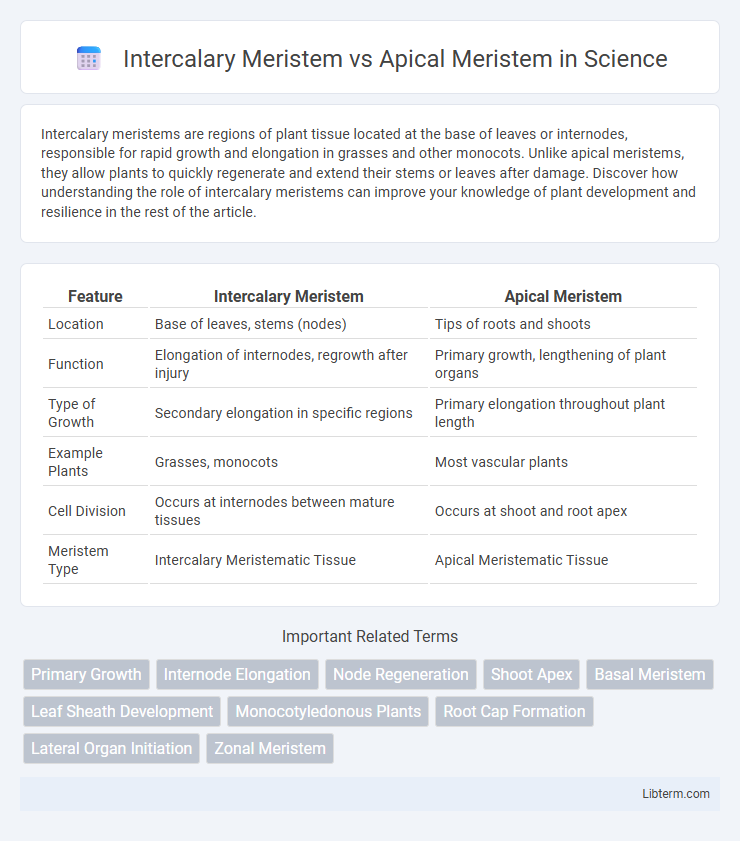Intercalary meristems are regions of plant tissue located at the base of leaves or internodes, responsible for rapid growth and elongation in grasses and other monocots. Unlike apical meristems, they allow plants to quickly regenerate and extend their stems or leaves after damage. Discover how understanding the role of intercalary meristems can improve your knowledge of plant development and resilience in the rest of the article.
Table of Comparison
| Feature | Intercalary Meristem | Apical Meristem |
|---|---|---|
| Location | Base of leaves, stems (nodes) | Tips of roots and shoots |
| Function | Elongation of internodes, regrowth after injury | Primary growth, lengthening of plant organs |
| Type of Growth | Secondary elongation in specific regions | Primary elongation throughout plant length |
| Example Plants | Grasses, monocots | Most vascular plants |
| Cell Division | Occurs at internodes between mature tissues | Occurs at shoot and root apex |
| Meristem Type | Intercalary Meristematic Tissue | Apical Meristematic Tissue |
Introduction to Meristems
Meristems are specialized plant tissues responsible for continuous growth and cell division, with apical meristems located at the tips of roots and shoots driving primary growth and elongation. Intercalary meristems, found at the base of leaves or internodes in monocots like grasses, enable rapid growth and regrowth by adding length between mature tissues. Understanding the distinct positions and functions of apical and intercalary meristems is crucial for insights into plant development and regenerative capacity.
Overview of Apical Meristem
Apical meristem is a primary growth tissue located at the tips of roots and shoots, responsible for the elongation of plants and formation of new organs such as leaves and flowers. It consists of undifferentiated cells that actively divide to facilitate vertical growth, enabling the plant to increase in height and root length. Unlike intercalary meristem, which is found at the base of internodes and leaves, apical meristem plays a crucial role in primary growth and the development of the plant's main axis.
Overview of Intercalary Meristem
Intercalary meristems are found at the base of leaves or internodes in monocots, enabling rapid growth and elongation of plant parts such as grass blades. Unlike apical meristems, which are located at the tips of roots and shoots for primary growth, intercalary meristems contribute to regrowth after injury or grazing. This unique positioning allows plants with intercalary meristems to maintain continuous growth despite environmental damage.
Key Differences Between Apical and Intercalary Meristems
Apical meristems are located at the tips of roots and shoots, responsible for primary growth and elongation, whereas intercalary meristems are found at the base of leaves or internodes, facilitating regrowth and leaf expansion. Apical meristems contribute to the formation of new organs and overall height increase, while intercalary meristems enable rapid repair and regrowth in monocots like grasses after damage. The distinct locations and functions of these meristems highlight their specialized roles in plant growth and development.
Location and Structure
Intercalary meristem is located at the base of leaves or internodes, allowing plants like grasses to grow in length from these middle regions, while apical meristem is found at the tips of roots and shoots, driving primary growth by elongating the plant. Structurally, intercalary meristems consist of undifferentiated, small, densely cytoplasmic cells arranged in groups, promoting regrowth after injury or grazing; apical meristems contain a dome-shaped mass of actively dividing cells protected by root caps or leaf primordia. The spatial positioning of intercalary meristems enables rapid elongation in specific segments, whereas apical meristems establish vertical growth and form new organs.
Functions of Apical Meristem
Apical meristem is the primary growth region located at the tips of roots and shoots, responsible for elongation and the formation of new organs such as leaves and flowers. It produces undifferentiated cells that differentiate into various tissues, enabling vertical plant growth and development. Unlike intercalary meristem, which facilitates growth at internodes and leaf bases mainly in monocots, apical meristem drives primary growth in all vascular plants.
Functions of Intercalary Meristem
Intercalary meristem plays a crucial role in plant growth by enabling elongation of internodes and the regeneration of damaged parts, particularly in monocots like grasses. This type of meristem facilitates rapid growth from the base of leaves or stems, allowing plants to recover quickly from grazing or mowing. Unlike apical meristems, which are located at the tips of roots and shoots and drive primary growth, intercalary meristems contribute to secondary elongation along mature tissues.
Examples in Plant Species
Intercalary meristems are typically found in monocots such as grasses (Poaceae family) including wheat and maize, where they enable elongation at the base of leaves or stems. In contrast, apical meristems are present in most vascular plants like Arabidopsis and pine trees, driving primary growth at root and shoot tips. The intercalary meristem's role in regrowth after grazing in grasses contrasts with the apical meristem's function in vertical growth and organ formation.
Role in Plant Growth and Development
Intercalary meristems enable rapid growth and elongation in grasses and monocots by adding cells at the base of leaves and internodes, facilitating regrowth after grazing or mowing. Apical meristems, located at the tips of roots and shoots, drive primary growth by producing new tissues that extend plant height and root length. Both meristems are essential for plant development but differ in their location and specific roles, with apical meristems supporting overall vertical expansion and intercalary meristems promoting localized regrowth and elongation.
Summary and Comparative Table
Intercalary meristems are located at the base of leaves or internodes, enabling growth in length after the initial elongation phase, commonly found in monocots like grasses. Apical meristems reside at the tips of roots and shoots, responsible for primary growth and elongation in most plants. The comparative table highlights apical meristems' role in vertical growth and organ formation versus intercalary meristems' function in rapid regrowth and repair of stem parts.
Intercalary Meristem Infographic

 libterm.com
libterm.com